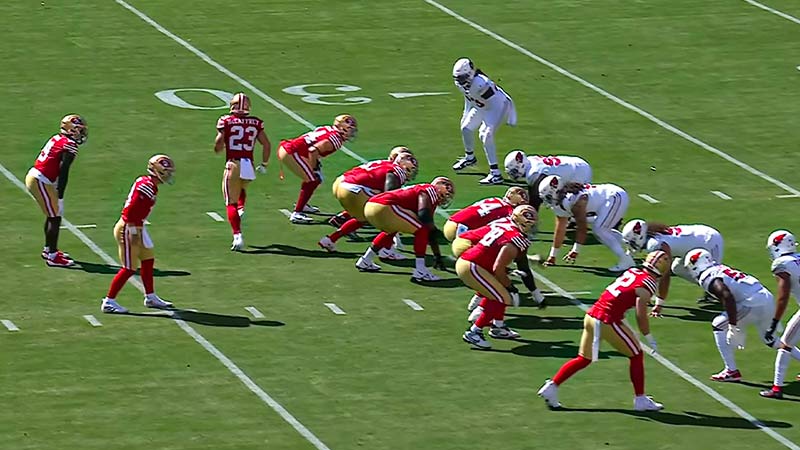In the gridiron symphony of American football, defensive linemen are guardians of the line of scrimmage, tasked with thwarting runs and disrupting passing plays.
This blog post delves into these athletes’ pivotal roles on the field.
From their initial stance to the explosive bursts that penetrate enemy lines, defensive linemen’s skills are an intricate dance of strength, agility, and strategic acumen.
We explore the evolution of defensive line strategies, the challenges these players face, and the multifaceted skill set required for success.
Whether it’s holding the fort against a running onslaught or executing precise pass-rushing moves, defensive linemen embody the epitome of tenacity in the heart of the football battlefield.
What Is the Defensive Linemen Football?
In American football, defensive linemen are players on the defensive team who line up in the front of the defense, typically in the line of scrimmage, with the primary goal of stopping the opposing team’s running plays and putting pressure on the quarterback during passing plays.
The defensive line is a crucial component of the overall defense and plays a key role in disrupting the opposing team’s offense.
There are several positions within the defensive line, each with specific responsibilities:
Defensive Tackles (DT)
These players line up in the interior of the defensive line, typically over or next to the offensive guards and centers.
Their primary responsibility is to stop the run, occupy blockers, and create disruption in the middle of the line.
Defensive Ends (DE)
Defensive ends line up on the outer edges of the defensive line, often outside the offensive tackles. They are responsible for both stopping the run and rushing the quarterback on passing plays.
Speed and agility are often crucial for defensive ends maneuvering around offensive linemen.
Defensive linemen need to have a combination of strength, agility, and quick reactions. They engage in physical battles with offensive linemen, trying to shed blocks, tackle ball carriers, and pressure the quarterback.
Effective defensive linemen can disrupt the timing of the opposing team’s plays, create turnovers, and contribute significantly to the defense’s overall success.
The defensive line is a fundamental part of a team’s defense, and the defensive linemen’s performance often directly impacts the success of the entire defensive unit.
Responsibilities of the Defensive Linemen on the Field
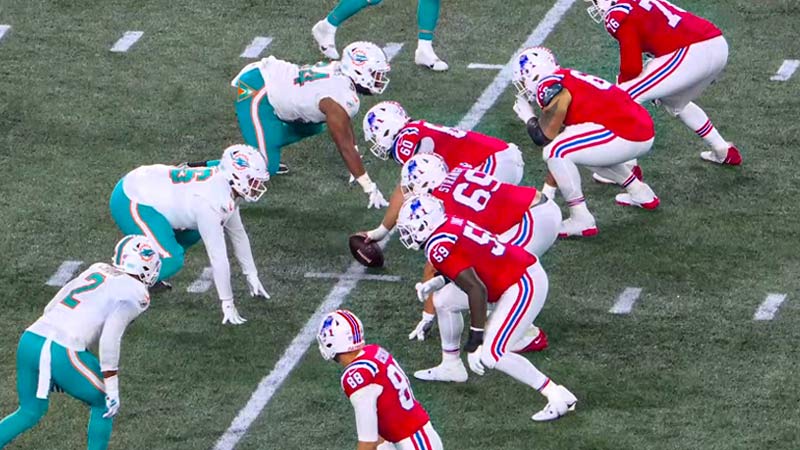
Defensive linemen in American football have various responsibilities on the field, and their roles can differ based on the defensive scheme employed by the team. However, some common responsibilities include:
Run Defense
- Gap Control: Defensive linemen are assigned specific gaps in the offensive line to control. They must read the play, fill their assigned gap, and work to stop running backs from gaining yardage.
- Tackling: Linemen are expected to make tackles on running backs and prevent them from advancing the ball downfield. This involves using proper tackling techniques and wrapping up the ball carrier.
- Penetration: Disrupting the offensive line by getting into the backfield can be crucial. Defensive linemen aim to penetrate the line of scrimmage, create chaos, and disrupt running plays.
Pass Rush
- Sacking the Quarterback: One of the primary roles of defensive linemen is to put pressure on the quarterback. This can lead to sacks (tackling the quarterback behind the line of scrimmage), hurries, or forced turnovers.
- Deflecting Passes: If linemen can’t reach the quarterback, they may try to disrupt passing lanes by getting their hands up to deflect or block the pass.
- Creating Pocket Collapse: Defensive linemen aim to collapse the pocket around the quarterback, making it difficult for them to find open receivers and execute their passing plays.
Disengaging Blocks
- Shedding Blocks: Offensive linemen try to block defensive linemen to protect their quarterback or create holes for running backs. Defensive linemen must use techniques to shed these blocks and make plays.
- Maintaining Leverage: Linemen work to maintain proper leverage, staying low and using their hands effectively to gain an advantage over offensive linemen.
Reading the Offense
- Recognizing Plays: Defensive linemen must quickly analyze the offensive formation, read the quarterback’s movements, and anticipate the type of play (run or pass) to react accordingly.
- Screen Recognition: Identifying screenplays and reacting quickly to disrupt them is important in defending against certain offensive strategies.
Team Communication
- Coordinating with Teammates: Linemen must communicate with linebackers, defensive backs, and other linemen to ensure proper coordination and execution of defensive strategies.
- Stunts and Twists: In some defensive schemes, linemen may execute stunts or twists, exchanging responsibilities to confuse the offensive line and creating openings for a pass rush.
Defensive linemen play a crucial role in the success of a football defense. Their ability to stop the run, pressure the quarterback, and disrupt offensive plays can significantly impact the outcome of a game.
The Anatomy of a Defensive Lineman in American Football
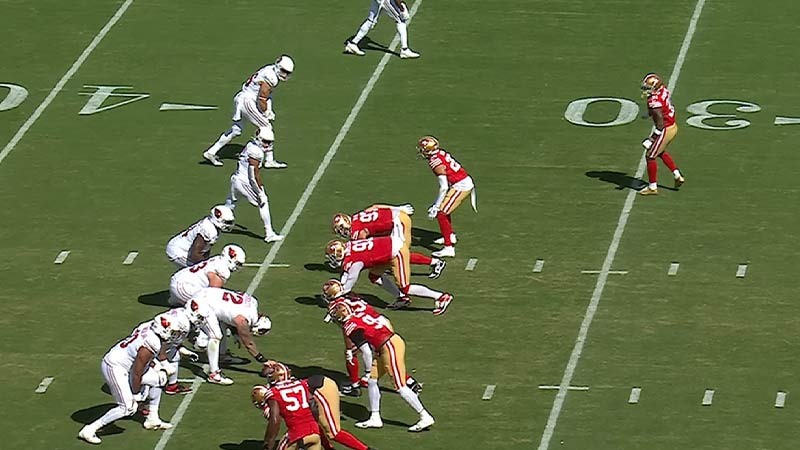
The anatomy of a defensive lineman in American football involves various physical and athletic attributes contributing to their effectiveness on the field.
Here are some key aspects of a defensive lineman’s anatomy:
Size and Strength
- Bulk: Defensive linemen are typically large and muscular to handle the physicality of the position. Size can provide an advantage in taking on blockers and stopping the run.
- Upper Body Strength: Powerful arms and shoulders are crucial for shedding blocks, engaging with offensive linemen, and controlling the line of scrimmage.
- Core Strength: A strong core helps with balance, stability, and generating power in movements.
Speed and Agility
- Initial Burst: Defensive linemen need explosive speed off the line of scrimmage to quickly penetrate into the backfield on pass-rushing plays.
- Lateral Quickness: Agility is essential for moving laterally along the line of scrimmage, especially when pursuing ball carriers or changing directions to elude blockers.
- Change of Direction: The ability to change direction quickly is vital for reacting to the movements of offensive linemen and pursuing the ball.
Technique
- Hand Placement: Proper hand placement is crucial for defensive linemen to effectively engage with offensive linemen, control blockers, and shed blocks.
- Pad Level: Maintaining a low pad level allows linemen to gain leverage against taller offensive linemen and helps drive through blockers.
- Pass Rush Moves: Effective defensive linemen use a variety of pass rush moves, such as swims, rips, and spins, to beat offensive linemen and pressure the quarterback.
Endurance and Conditioning
- Stamina: Defensive linemen must be in excellent physical condition to withstand the demands of playing in the trenches for an entire game.
- Cardiovascular Fitness: While defensive linemen may not cover much ground in a straight line, they engage in intense bursts of activity that require good cardiovascular fitness.
Mental Attributes
- Football IQ: Understanding offensive schemes, recognizing plays, and quickly reacting to the actions of the offensive line requires a high football intelligence.
- Focus and Discipline: Defensive linemen must maintain focus and discipline in their assignments and avoid penalties that could hurt the team.
Injury Prevention
- Flexibility: Maintaining flexibility helps avoid injuries, especially when linemen are subjected to various physical stresses.
- Joint Stability: Strong and stable joints are important for absorbing contact and preventing injuries during collisions on the field.
Recovery
- Recovery Techniques: Given the physical demands of the position, defensive linemen often use various recovery techniques, such as ice baths, massage, and stretching, to recover quickly between games and practices.
A successful defensive lineman possesses a combination of size, strength, speed, agility, technique, and mental acuity.
Training and conditioning programs are designed to enhance these attributes, allowing defensive linemen to excel in their roles on the football field.
Evolution of Defensive Line Strategies
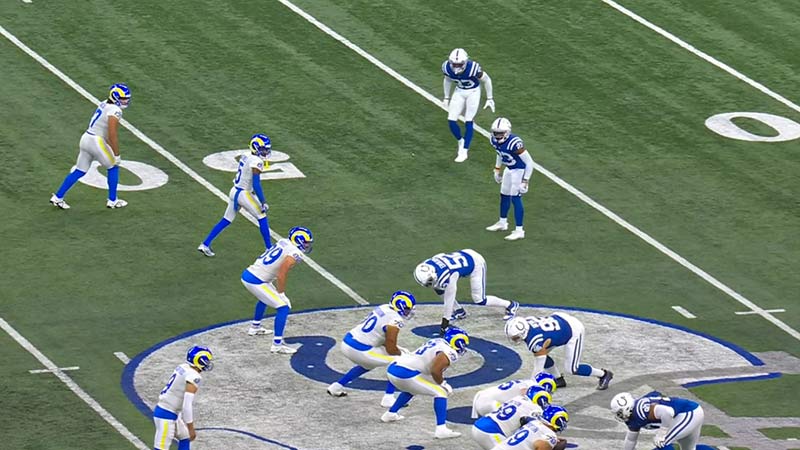
The evolution of defensive line strategies in American football has been influenced by changes in offensive schemes, rule modifications, and innovations in coaching and player development.
Here’s an overview of how defensive line strategies have evolved over the years:
Early Years
In the early days of football, defensive linemen often played two-way roles, participating in both offensive and defensive plays.
Strategies were rudimentary, emphasizing size and strength to overpower opponents in the trenches.
4-3 Defense
The advent of the 4-3 defense, popularized in the 1950s and 1960s, introduced a four-man defensive line consisting of two defensive ends and two defensive tackles.
Defensive ends focused on containment and pass rushing, while tackles were key in stopping the run.
3-4 Defense
In the 1970s, the 3-4 defense gained popularity. This formation features three defensive linemen and four linebackers.
Defensive linemen in a 3-4 scheme often had more versatile roles, with ends sometimes dropping into coverage and tackles responsible for occupying blockers to free up linebackers.
Pass-Rushing Specialists
As the passing game became more prominent, the role of pass-rushing specialists emerged. Some defensive ends, in particular, became specialists in rushing the quarterback, using speed and agility to get to the passer.
Hybrid Defenses
Modern defensive strategies often involve hybrid schemes that blend elements of the 4-3 and 3-4 defenses. This flexibility allows defenses to adapt to different offensive formations and play styles.
Defensive linemen in these systems are expected to be versatile, capable of both stopping the run and rushing the passer.
Interior Pressure
There’s a growing emphasis on generating pressure up the middle of the offensive line. Defensive tackles that can collapse the pocket and disrupt the quarterback’s vision have become highly valued.
Technique Emphasis
Coaching techniques for defensive linemen have evolved, emphasizing hand placement, pad level, and pass-rushing moves.
Defensive linemen are now trained to read offensive plays, recognize blocking schemes, and react more quickly to the actions of the opposing offensive line.
Analytics and Technology
The use of analytics and technology has impacted defensive line strategies. Teams analyze data to identify tendencies in opponents, optimize player positioning, and make strategic adjustments.
Subpackages and Rotations
Teams often employ subpackages and rotation strategies to keep defensive linemen fresh throughout the game. This allows for specialization based on down-and-distance situations.
Versatility
Modern defensive linemen are expected to be more versatile and able to play multiple positions along the line. This versatility allows for creative defensive alignments and matchups.
Stunts and Blitzes
Defensive coordinators incorporate stunts and blitz packages to confuse offensive linemen and create mismatches. Linemen are coached on various pass-rushing moves and techniques to break through blocking schemes.
Rule Changes
Rule changes, such as those aimed at protecting quarterbacks, impact defensive line strategies. Defensive linemen must adjust their approach to avoid penalties and adapt to the evolving nature of the game.
The evolution of defensive line strategies reflects the constant adaptation to offensive innovations, changes in rules, and advancements in coaching and player development.
Teams continually seek ways to disrupt opposing offenses and create a competitive advantage through strategic and tactical adjustments on the defensive line.
Challenges of Defensive Line Football
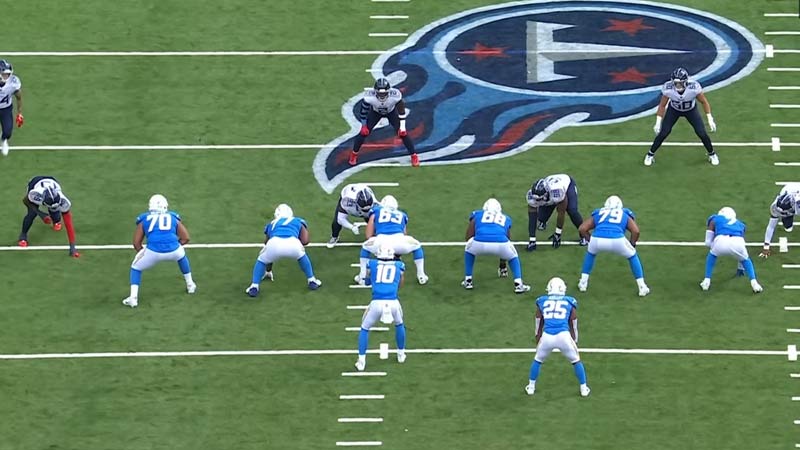
Defensive linemen in football face various challenges on the field, and success in overcoming these challenges is crucial for the defense’s overall performance.
Here are some of the key challenges faced by defensive linemen:
Blockers and Double-Teams
Offensive linemen, tight ends, and sometimes running backs work together to block defensive linemen. This can involve one-on-one matchups or double-teams, making it challenging for a defensive lineman to get to the quarterback or stop a running back.
Run Defense
Stopping the run is a primary responsibility for defensive linemen. They must read the play, shed blocks, and tackle ball carriers. Effective running backs and well-executed blocking schemes pose significant challenges.
Pass Rush
Generating pressure on the quarterback is crucial, but offensive linemen are trained to protect their quarterbacks. Defensive linemen face challenges in finding ways to beat blockers and reach the quarterback, especially with the emphasis on quick releases in modern passing offenses.
Injuries and Physical Toll
Defensive linemen engage in physically demanding and often violent collisions on every play. The risk of injuries, including concussions, strains, and sprains, is high. The physical toll over the course of a season can be challenging for these players.
Adjusting to Rule Changes
Rule changes, particularly those aimed at protecting quarterbacks, can be challenging for defensive linemen. Adjusting their playing style to comply with new rules while remaining effective is an ongoing challenge.
Versatility
Modern defensive schemes often require linemen to be versatile and capable of playing multiple positions along the defensive line. Adapting to different roles and responsibilities can be challenging for players accustomed to specific positions or roles.
Read-and-React
Defensive linemen must read the offense quickly and react appropriately. This involves recognizing play-action, screenplays, and other deceptive tactics employed by offenses. Misreading a play can lead to the wrong pursuit angle or assignment breakdown.
Fatigue
The physical exertion required to battle offensive linemen on every play can lead to fatigue. Staying effective late in games and throughout the season is a challenge, especially considering the high number of snaps defensive linemen often play.
Mental Toughness
Defensive linemen need mental toughness to overcome setbacks, such as being blocked or facing double-teams repeatedly. Maintaining focus and discipline, especially when the offense employs various strategies, is crucial.
Offensive Innovations
Offensive coordinators continually innovate to exploit defensive weaknesses. Defensive linemen must adapt to new offensive schemes, unconventional formations, and quick-tempo offenses, requiring a high level of football IQ.
Size Disparities
Defensive linemen often face offensive linemen who are larger and heavier. Overcoming size disparities and using techniques to gain leverage can be challenging, especially for smaller or quicker linemen.
Penalty Avoidance
Rule enforcement can impact defensive linemen, particularly in terms of avoiding penalties like offsides or unnecessary roughness. Striking a balance between aggression and disciplined play is crucial.
Overcoming these challenges requires a combination of physical prowess, technical skill, mental acuity, and adaptability.
Successful defensive linemen continuously refine their techniques, study opponents, and stay mentally and physically prepared for the demands of their position.
FAQs
What is the primary role of defensive linemen in American football?
Defensive linemen have a dual responsibility—stopping the run by engaging with blockers to disrupt plays and pressuring the quarterback on passing plays.
Their physicality, technique, and ability to read offensive plays are crucial in maintaining a stout defense.
How do defensive linemen contribute to the pass rush?
Defensive linemen contribute to the pass rush by using techniques such as swimming, rips, and spins to beat blockers.
Their speed, agility, and ability to collapse the pocket disrupt the quarterback’s timing and create opportunities for sacks and turnovers.
What skills are essential for successful defensive linemen?
Successful defensive linemen possess a combination of size, strength, speed, and agility.
Also, mastering hand placement, pad level, pass-rushing moves, and a high football IQ to read and react to offensive plays are crucial for effectiveness in the trenches.
How have defensive line strategies evolved in American football?
Defensive line strategies have evolved with the game, adapting to offensive innovations.
From traditional 4-3 and 3-4 defenses, modern schemes emphasize versatility, interior pressure, and strategic rotations.
Defensive linemen now use analytics and technology to enhance performance and counteract evolving offensive tactics.
What challenges do defensive linemen face during a game?
Defensive linemen contend with blockers, double-teams, and the physical toll of every play.
Challenges include stopping the run, generating a pass rush against well-protected quarterbacks, adapting to rule changes, and maintaining mental toughness.
Versatility, adaptability, and avoiding penalties are also constant challenges in the dynamic environment of American football.
Wrapping Up
In the high-stakes arena of American football, defensive linemen emerge as unsung heroes, sculptors of victory in the trenches.
From the early days of brute force to the nuanced, strategic ballet of modern gameplay, their evolution mirrors the ever-changing landscape of the sport.
These athletes, grappling with blockers, overcoming challenges, and adapting to innovations, exemplify the essence of resilience and skill.
The dynamic fusion of size, strength, and intelligence encapsulates their contribution to the team’s success.
As we conclude our exploration into the realm of defensive linemen, we recognize them not merely as guardians of the line but as architects of defensive prowess.
The vital is to the grand tapestry of American football—a testament to the enduring spirit of competition, strategy, and athleticism on the gridiron.

